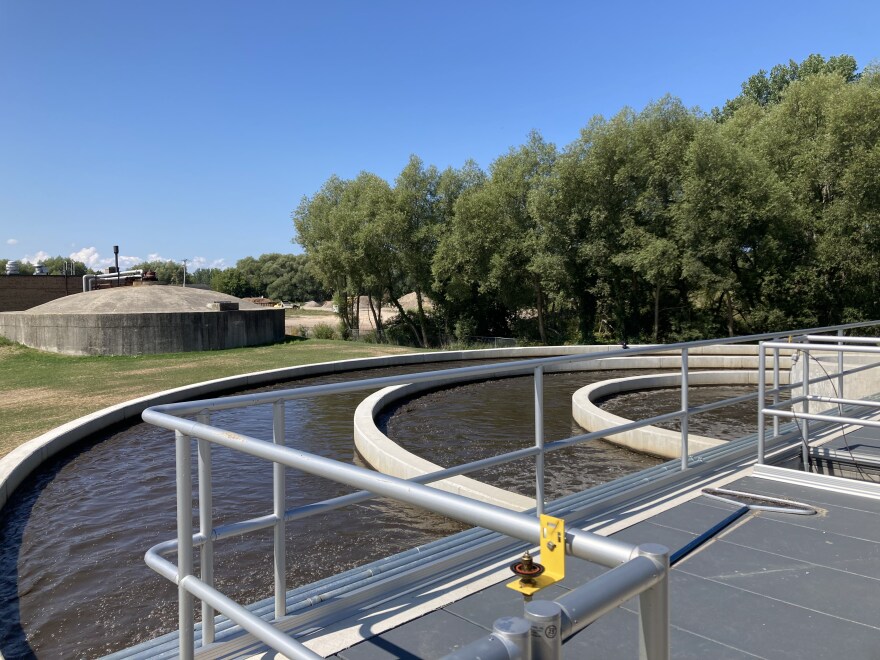Michigan doesn’t have the best report card when it comes to infrastructure. The state received a D+ for drinking water and a C for wastewater systems from the American Society of Civil Engineers, but state funding is slowly turning the tide.
A facility in Cheboygan is benefitting from state investment, and public officials were recently able to implement long-overdue updates.
Cobwebs and the musty smell of mold linger in a room at the Cheboygan wastewater treatment plant.
The hall is filled with several large barrels known as rotating biological contactors (RBCs) that played a key role in the plant’s old treatment process.
The RBCs have a 20-to-25-year lifespan, but at this plant, they ran for more than 40 years.
“I want to take you in here to show the horror show of what we used to deal with,” said Jason Karmol, the public works director for the city of Cheboygan.

Karmol doesn’t hold back in sharing what it’s like working with deteriorating infrastructure.
“We had wheels breaking, and the concrete was so brittle, that we'd have to weld plates to anchor the metal," Karmol said. "Then the disheartening part is, I'd see them work all day, and we’d come back in the morning. The thing is ripped out of the concrete, and we’re right back at it again.”
As of six or so months ago, the RBCs are no longer operating.
Now, the plant has a new tool called an oxidation ditch that replaces the aging barrels. Wastewater peacefully flows into the large funnel-like pool while microbes – affectionately known as “bugs” – feast on sewage.

Instead of dealing with potentially dangerous chemicals like chlorine gas, plant operators now “micro-manage" the bugs treating the water and make sure their work environment isn’t toxic.
“Because we're so dependent on biology now, and we're not dependent on chemicals, we have to protect those bugs that are doing all the work for us,” Karmol said.
Upgrades like the oxidation ditch and improved storm water infrastructure are a result of a $20 million loan from the state – a quarter of which will not need to be paid back.
Karmol said prior to the updates, the plant's treated water that was discharged into the Cheboygan River was often violating permit requirements on water quality.
“In 2006, we started getting lots of violations, and me coming here didn't do anything to solve that because I'd had the same equipment,” Karmol said.

The Michigan Department of Environment of Great Lakes, and Energy (EGLE) distributed nearly $360 million in loans this year to support 20 infrastructure projects that focus on wastewater and drinking water systems.
Dan Beauchamp, with EGLE's water infrastructure financing division, said federal dollars and increases in the state budget have resulted in historic funding availability for water systems in 2023 and 2024.
“While this a tremendous amount of funding the state and federal government is investing in infrastructure, unfortunately, there's more need than in a given fiscal year, then what we have available for funding,” Beauchamp said.
The state previously prioritized what it considered "disadvantaged communities." Now, EGLE scores communities as "overburdened" and "significantly overburdened," which allows for a broader spectrum of applicants.
Cheboygan qualified for the loan in 2021 under the state's old "disadvantaged status," but Karmol said changes in the loan program have helped make funding more accessible.
“They've changed their loan structure to be more competitive, and they've also added that principal forgiveness twist," Karmol said. "Now, I bet you they get calls all the time.”
Beauchamp said he doesn’t know how much investment it would take to raise Michigan’s failing water infrastructure grades. Estimates vary – the Michigan Civil Engineers says annual investment falls short $410-710 million, not including PFAS concerns and lead service line replacement.
In Governor Gretchen Whitmer's MI Clean Water plan, the state references an $800 million annual gap needed to upgrade the state’s sewer and water infrastructure.
“What I can say is that the money is gonna go a long way to addressing a lot of drinking water and wastewater needs for these communities that received the funding,” Beauchamp said.
The 2024 state budget allocates nearly $600 million for Michigan’s water infrastructure, which includes $280.5 million for the loan program and millions more in funding for grants.
Water infrastructure is more hidden from the public eye unlike roads, Beauchamp said, where people notice when they’re crumbling and when they’re fixed.
“And they don't know that there's a problem until they don't have water or there’s a discharge on a beach, but the underground infrastructure is obviously critical for all of us,” Beauchamp said.
At the Cheboygan wastewater treatment plant, Karmol said morale has significantly improved since making the upgrades.
“We don't want to go home and, you know, work all day and fail," Karmol said. "It was very frustrating to not have the tools to treat and have the state say you need to do better."
Even though water quality violations have stopped, the work isn’t over. Plant operators are still getting to know their microscopic coworkers and fine-tuning the system to meet the community’s ever-changing needs.
"Now, we actually have the tools to feel good about what we do, we're putting a good quality effluent into the river,” Karmol said.
Now, Karmol said the city is turning to its drinking water infrastructure with a plan to build a new water tower and replace old water mains.

As far as the RBCs, those 40-year-old, broken down barrels, the plant is working to get them removed with a state grant.
While they're a monument to the plant's progress, they're also a potential source of black mold.
With them gone, the plant is ushering in a new era, one that's in tune with the Cheboygan River.





